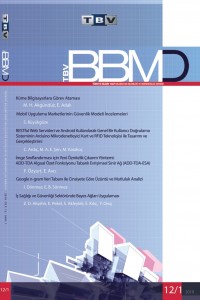Öz
Günümüzde
başarımı yeterli sayılabilecek düşük maliyetli atanmış bilgisayarlar değişik
alanlarda kullanılmaktadır. Bu makalede, bu tür atanmış bilgisayarların küme
yapısında kullanılmalarına yönelik bir çalışmanın sonuçları anlatılmıştır.
Çok
sayıda işlem gerektiren uygulamalarda bazı işlemler yinelenmektedir; bazı
işlemlerin art arda yapılması gerekir; bazı işlemler de koşut biçimde
gerçekleştirilebilir. İşlemlerin süresi değişken olabilir. Koşut işlemler aynı
anda gerçekleştirilebilirler. Tek kısıt kümedeki bilgisayar sayısıdır. Art arda
yapılması gereken işlemler, doğası gereği birbirini beklerler.
Bu
makalede, yukarıda belirtilen koşullarda, işleri küme içindeki bilgisayarlara
dağıtacak yeni bir algoritma tanıtılacak ve uygulama örnekleri sunulacaktır.
Anahtar Kelimeler
Kaynakça
- [1]. History of Processor Performance, http://www.cs.columbia.edu/~%20sedwards/classes/20 12/3827-spring/advanced-arch-2011.pdf
- [2]. M.H. AKGUNDUZ, E. ADALI,Atanmış Sistemler ile Bilgisayar Kümesi Tasarımı ve Mevcut Sistemler ile Karşılaştırması. TBV, Bilgisayar Bilimleri ve Mühendisliği Dergisi, Sayı:8.2, 2015
- [3]. J.A. BANNISTER, K.S. TRIVEDI, Task Allocationin Fault-Tolerant Distributed Systems.ActaInformatica, Vol:20, 1983
- [4]. S. HARIRI, C. S. RAGHAVENDRA, Distributed Functions Allocation for Reliability and Delay Optimization, ACM '86 Proceedings of 1986 ACM Fall joint computer conference, 1986
- [5]. S.M. SHATZ, J. WANG, M. GOTO,TaskAllocation for Maximizing Reliability of Distributed Computer Systems IEEE Transactions on Computers Volume 41 Issue 9, September 1992
- [6]. S. KARTIK, C.S.R. MURTHY, Task Allocation Algorithms for Maximizing Reliability of Distributed Computing Systems, IEEE Transactions on Computers Volume 46 Issue 6, 1997
- [7]. E. ADALI, Dağıtılmış Bilgisayarlarla Denetim Doçentlik Tezi, İSTANBUL, TR. 1980
- [8]. P.R. MA, E.Y.S. LEE,M. TSUCHIYA, A TaskAllocation Model for Distributed Computing Systems,IEEE Transactions on Computers Volume 31 Issue 1, 1982
- [9]. A.KHANDELWAL, Optimal Execution Cost of Distributed System through Clustering, International Journal of EngineeringS cience and Technology, Vol: 3, issue: 3, 2011.
- [10]. YOUNES, Task Allocation forMinimizing Cost of Distributed Computing Systems Using Genetic Algorithms, International Journal of Advanced Research in Computer Science and Software Engineering, vol: 2, issue: 9, 2012
- [11]. L.Rudolph,M.S. Allalouf, E.Upfal, A Simple Load Balancing Scheme for Task Allocationin Parallel Machines, SPAA '91 Proceedings of the third annual ACM symposium on Parallel algorithms and architectures, 1991
- [12]. G. PFISTER, Cluster Computing, Encyclopedia of ComputerScience, John WileyandSons Ltd., ChichesterUK, 2000
- [13]. A.B. KAHN, TopologicalSortingof Large Networks, Communications of the ACM, 5 (11), 1962
- [14]. U. A. ACAR, A. CHARGUÉRAUD, M. RAINEY, A Work-EfficientAlgorithmforParallelUnordered Depth- First Search, SC '15: Proceedings of the International Conference for High Performance Computing, Networking, Storage and Analysis, Austin, TX, 2015
- [15]. C. E. LEISERSON, T. B. SCHARDL. A Work-Efficient Parallel Breadth-First Search Algorithm,SPAA ’10, ACM,New York, NY, USA, 2010
- [16]. G. E. BLELLOCH, J. T. FINEMAN, P. B. GIBBONS, J. SHUN.Internally deterministic can be fast. PPoPP ’12,ACM, New York, NY, USA, 2012
- [17]. J. SHUN and G. E. BLELLOCH. Ligra: A Lightweight Graph Processing Framework For Shared Memory, PPOPP ’13,ACM, New York, NY, USA, 2013
Öz
Kaynakça
- [1]. History of Processor Performance, http://www.cs.columbia.edu/~%20sedwards/classes/20 12/3827-spring/advanced-arch-2011.pdf
- [2]. M.H. AKGUNDUZ, E. ADALI,Atanmış Sistemler ile Bilgisayar Kümesi Tasarımı ve Mevcut Sistemler ile Karşılaştırması. TBV, Bilgisayar Bilimleri ve Mühendisliği Dergisi, Sayı:8.2, 2015
- [3]. J.A. BANNISTER, K.S. TRIVEDI, Task Allocationin Fault-Tolerant Distributed Systems.ActaInformatica, Vol:20, 1983
- [4]. S. HARIRI, C. S. RAGHAVENDRA, Distributed Functions Allocation for Reliability and Delay Optimization, ACM '86 Proceedings of 1986 ACM Fall joint computer conference, 1986
- [5]. S.M. SHATZ, J. WANG, M. GOTO,TaskAllocation for Maximizing Reliability of Distributed Computer Systems IEEE Transactions on Computers Volume 41 Issue 9, September 1992
- [6]. S. KARTIK, C.S.R. MURTHY, Task Allocation Algorithms for Maximizing Reliability of Distributed Computing Systems, IEEE Transactions on Computers Volume 46 Issue 6, 1997
- [7]. E. ADALI, Dağıtılmış Bilgisayarlarla Denetim Doçentlik Tezi, İSTANBUL, TR. 1980
- [8]. P.R. MA, E.Y.S. LEE,M. TSUCHIYA, A TaskAllocation Model for Distributed Computing Systems,IEEE Transactions on Computers Volume 31 Issue 1, 1982
- [9]. A.KHANDELWAL, Optimal Execution Cost of Distributed System through Clustering, International Journal of EngineeringS cience and Technology, Vol: 3, issue: 3, 2011.
- [10]. YOUNES, Task Allocation forMinimizing Cost of Distributed Computing Systems Using Genetic Algorithms, International Journal of Advanced Research in Computer Science and Software Engineering, vol: 2, issue: 9, 2012
- [11]. L.Rudolph,M.S. Allalouf, E.Upfal, A Simple Load Balancing Scheme for Task Allocationin Parallel Machines, SPAA '91 Proceedings of the third annual ACM symposium on Parallel algorithms and architectures, 1991
- [12]. G. PFISTER, Cluster Computing, Encyclopedia of ComputerScience, John WileyandSons Ltd., ChichesterUK, 2000
- [13]. A.B. KAHN, TopologicalSortingof Large Networks, Communications of the ACM, 5 (11), 1962
- [14]. U. A. ACAR, A. CHARGUÉRAUD, M. RAINEY, A Work-EfficientAlgorithmforParallelUnordered Depth- First Search, SC '15: Proceedings of the International Conference for High Performance Computing, Networking, Storage and Analysis, Austin, TX, 2015
- [15]. C. E. LEISERSON, T. B. SCHARDL. A Work-Efficient Parallel Breadth-First Search Algorithm,SPAA ’10, ACM,New York, NY, USA, 2010
- [16]. G. E. BLELLOCH, J. T. FINEMAN, P. B. GIBBONS, J. SHUN.Internally deterministic can be fast. PPoPP ’12,ACM, New York, NY, USA, 2012
- [17]. J. SHUN and G. E. BLELLOCH. Ligra: A Lightweight Graph Processing Framework For Shared Memory, PPOPP ’13,ACM, New York, NY, USA, 2013
Ayrıntılar
| Birincil Dil | Türkçe |
|---|---|
| Bölüm | Makaleler(Araştırma) |
| Yazarlar | |
| Yayımlanma Tarihi | 1 Haziran 2019 |
| Yayımlandığı Sayı | Yıl 2019 Cilt: 12 Sayı: 1 |
Kaynak Göster
https://i.creativecommons.org/l/by-nc/4.0Makale Kabulü | |
Çevrimiçi makale yüklemesi yapmak için kullanıcı kayıt/girişini kullanınız. Dergiye gönderilen makalelerin kabul süreci şu aşamalardan oluşmaktadır: 1. Gönderilen her makale ilk aşamada en az iki hakeme gönderilmektedir. 2. Hakem ataması, dergi editörleri tarafından yapılmaktadır. Derginin hakem havuzunda yaklaşık 200 hakem bulunmaktadır ve bu hakemler ilgi alanlarına göre sınıflandırılmıştır. Her hakeme ilgilendiği konuda makale gönderilmektedir. Hakem seçimi menfaat çatışmasına neden olmayacak biçimde yapılmaktadır. 3. Hakemlere gönderilen makalelerde yazar adları kapatılmaktadır. 4. Hakemlere bir makalenin nasıl değerlendirileceği açıklanmaktadır ve aşağıda görülen değerlendirme formunu doldurmaları istenmektedir. 5. İki hakemin olumlu görüş bildirdiği makaleler editörler tarafından benzerlik incelemesinden geçirilir. Makalelerdeki benzerliğin %25’ten küçük olması beklenir. 6. Tüm aşamaları geçmiş olan bir bildiri dil ve sunuş açısından editör tarafından incelenir ve gerekli düzeltme ve iyileştirmeler yapılır. Gerekirse yazarlara durum bildirilir.
|



